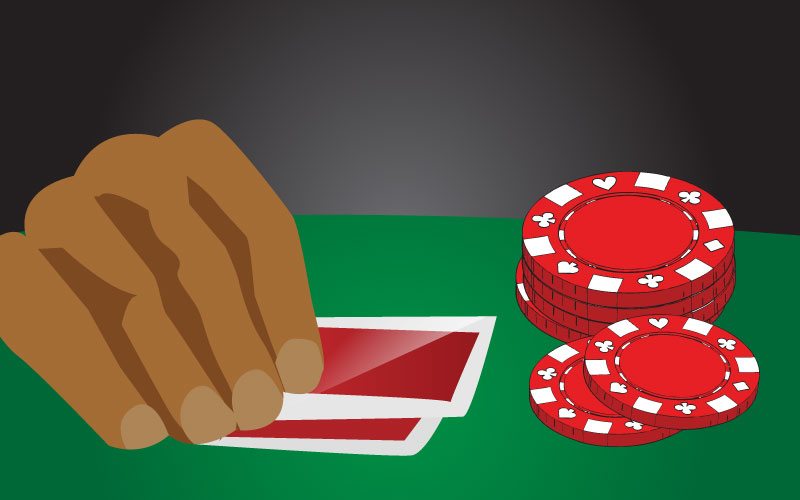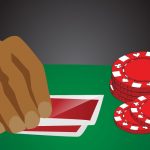Often in live games you will see the looser, gambling players posting a live straddle. What is it? How does it affect the game and what should we do about it? This article will take a more technical online-like view of the phenomenon usually only seen in live games.
Mechanics of the UTG Live Straddle
The UTG player posts an extra blind, usually twice the size of the big blind before looking at their cards. In exchange they get to act last pre-flop. Position remains the same after the flop.
Usually the player straddling is loose and sometimes (but not always) quite aggressive. Raising out of the straddle to blow players who limp weak hands off of them is a common strategy that can be very profitable given the double cost of limping. Calling raises with a wide range due to “pot odds” is much more common. He’s showing the table he came to gamble!
Effect of the UTG Live Straddle on Other Players
The straddle has its most profound effect on the blinds. Value lost by the forced blind bets is picked up by the other positions at the table.

Winning poker is about minimizing your losses from the blinds and maximizing your gains by attacking the blinds and weaker players.
However, the blinds are not all sunk cost. They make back some of the cost of the blinds in the following ways:
-
Getting to see free and discounted flops. Particularly from the big blind which gets free flops or can often close the action with a call.
-
Pre-flop position. Acting later pre-flop gives your monster hands like Aces and Kings more value than you would have gotten from early position because you will get action from other hands that have already entered the pot that otherwise would have folded to an early position open.
-
Chopping when it’s folded to the blinds. This is common in smaller raked games. Sometimes the button will even be nice and social by folding playable hands so the blinds can chop!
-
Stealing the BB when it’s folded to the SB.
-
Defending the BB with position when the SB tries to steal.
However, having a straddle posted messes most of that up.
-
You no longer get any free flops from the BB, never close the action with a call, and the SB’s discount to see flops is effectively nullified by having 2 players to act if he completes.
-
You lose some of your pre-flop position and have a loose player acting after you.
-
Many card rooms will not allow chopping blinds with a straddle in play and many straddlers won’t chop anyway.
-
Stealing is complicated because the straddler will often defend with position.
The blinds lose value. However, all the other positions gain value. Having the extra dead money in the pot more than makes up for a slight loss of pre-flop position. Other positions also have post-flop position on the straddle.
How to Adjust to an UTG Live Straddle
The first thing to consider is: How deep is the money?
If most of the stacks are 200+ times the size of the big blind, you’re probably not far off by just playing the game as if the blinds were twice as big. That said, keep in mind that the dollar value of bets may put other players into uncomfortable spots. You may get more fold equity with smaller bets relative to the pot and the other players will tend to pot control and under-bet the pot in spots where they otherwise would not have. However, many live games only play an effective 100bb or even 50bb deep.
With shallower stacks you need to consider pot control.
-
Don’t raise with hands like middle/small pocket pairs and the smaller suited broadways you might otherwise have raised to build a pot and balance your raises with stronger hands. In a straddled pot without deep money, usually the pot is already built by the extra action from the straddle. If you raise, you then risk building an out-of-control pot where you have less room to make decisions and will have to commit with a wide range of lukewarm hands.
-
Balance your wider limping range by limping your strongest hands (QQ+/AK) more often, particularly if the straddle likes to attack limpers!
-
Consider smaller relative raises to give yourself room to make post-flop decisions. If your standard open is 4x or 5x the big blind, consider 2.5x or 3x the straddle instead. The pot will still be larger, however you will have more room to play post-flop poker and encourage the straddler and blinds to (mis)play far more weak hands out of position against you.
From early position play is otherwise unchanged. From middle position you need to consider that there is an extra hand remaining to act post-flop. So tend to tighten up your opening requirements by about one position. This concept extends to the button where you might have raised a wide range of hands. Now you need to consider both that you have an extra hand remaining to act and the straddle is likely a player who will defend lightly against a button raise. Because of this your button opening range in a straddled pot should be closer to your cut-off opening range than your typical button range.
The blinds are really in a tough spot. If the player to your immediate left is regularly straddling then you should consider a seat change, particularly short handed. The small blind is now facing two blinds with position and should play very tight. The big blind should play it much like the small blind in a regular small vs big confrontation. Even after limpers the small blind should be playing very tight because seeing a flop at about ¾ the cost out of position isn’t worth it facing two players to act who may still raise.
The Short Stack (Suicide) Straddle
Many players play cash games like a tournament and will not re-buy until they get stacked. Or they will come to the table with only one buy-in. After getting short stacked, a strategy they will often employ is to straddle intending to shove any hand with all-in value, hoping to gamble off the short stack to either go broke or regain a stack with more play in it. Their pushing range is probably something like any pair, any ace, maybe any two broadways, maybe suited connectors (especially multi-way!), their favorite rag hand, etc. I call this a suicide straddle as it conjures images of a cornered solider attaching his bayonet and charging BANZAI!
When you see a short stack suddenly start straddling you should adjust by folding the speculative hands you’re not willing to at least call a push from the straddle so you are not caught leaving dead money in the pot if the straddle pulls the trigger. Also, if you raise, consider making your raise small enough that a push from straddle re-opens the action so you can go over the top of anyone caught in between. Finally, it can be a good spot for limping (even deep limping) QQ+/AK, however don’t take it as a given that the suicide straddle will push. He will often be happy to just see a flop with his worst hands and about a single bet left behind.
Should You Straddle?
First we must consider the cost of straddling. Like any other blind the expected cost of straddling is primarily a function of your skill level relative to the other players and number of other hands dealt. The more hands dealt, the higher of a chance you’ll run into a very strong hand (or strong player with a good hand) that crushes your equity. Hence, the more short handed a game is and the better you read your opponent’s hands, the lower the effective cost of straddling is going to be. For a three handed game, having position on all three streets and putting added pressure on the blinds can give straddling a positive expectation. Finally, consider the cost of the rake. In a heavily raked game, having to contest more pots will increase your rake expose and make straddling more expensive.
That said, it often comes down to doing something foolish to make a greater fool out of someone else. If straddling gets other players to do it (particularly getting the button in straddled pots), it may be worth it. Also, if you can raise the effective stakes of the game (and get other players wagering uncomfortable amounts on routine hands) it can be worth it to get the entire or bulk of the table to agree to straddle (if the nit is on your left all the better.) It also may be a fairly cheap but well received gesture to give action so the more recreational players give you action in return or even invite you back to a very juicy private game.
Submit your review | |










